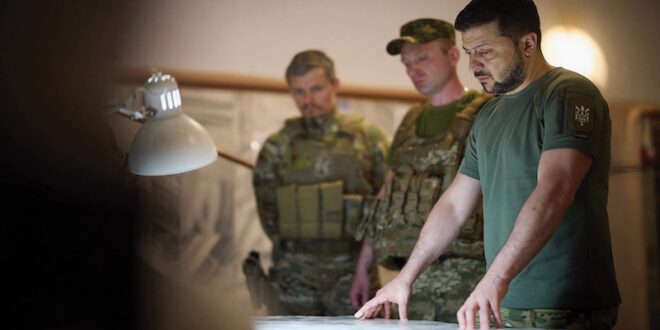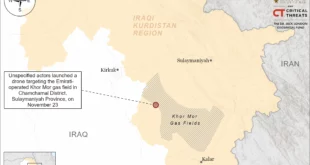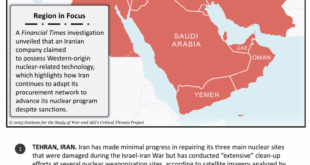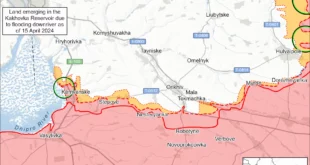The joint force is in a period of introspection, realizing, after two decades of counterinsurgency operations, that it has lost its monopoly on power. When military professionals and scholars discuss the ways the character of war has changed, they focus most on the blurring of traditional elements of conflict—that is, the gray zone.1 U.S. adversaries have become increasingly adept over the past quarter-century at achieving their goals in a manner that is deliberately designed to remain below the threshold of conventional military conflict and open interstate war. One such method, the use of lawfare, involves using law as a weapon to achieve a particular objective. The application of law as a means and method of war is not new. However, in today’s era of Great Power competition, Russia and China expertly combine lawfare with information operations, while the U.S. Government, possessing substantial capacity, has no overarching lawfare strategy. This article serves as a primer on the topic of lawfare, discusses its use by Russia, China, and the United States, and finally, reviews ways in which senior leaders must respond with changes to the organization of legal capabilities.
History of Lawfare
Lawfare, although a relatively new term, has always been particularly well-suited to competition below the threshold of conventional military conflict. Indeed, the use of law as a weapon of war arguably goes back to the early 1600s, when Hugo Grotius, the so-called father of modern international law, promoted the idea of the freedom of the seas.2 He thereby secured seafaring trade routes for the Dutch East India Company, an objective that Dutch military power could never have obtained in open conflict with Portugal’s naval command.3 As other nations accepted his premises, not only was the concept of international law born but also a new method for achieving aims against an adversarial country without war.
Lawfare has always thus been intricately linked to information. The term lawfare was popularized shortly after September 11, 2001, in an essay by then-Colonel Charles Dunlap, Jr., USAF. Now a noted scholar on the law of armed conflict, retired Major General Dunlap, a former Deputy Judge Advocate General of the Air Force, defines lawfare as “the use of law as a means of accomplishing what might otherwise require the application of traditional military force,” particularly by “those unable to challenge America’s high-tech military capabilities.”4 General Dunlap originally focused on the Taliban’s unlawful positioning of forces in or around protected places in hopes of deterring attacks or, even more preferable, using disinformation to accuse the United States and its allies of harming innocent civilians.5 In response to such actions, the United States and its partners created targeting restrictions beyond what is required by international law, giving the Taliban operating space that it could not have achieved on its own.6 Nonstate actors have mimicked such conduct throughout the Middle East, with a common scenario:
Insurgents fire on U.S. or allied troops from mosques in clear violation of international law.
U.S. and allied forces return fire in a proportional manner in accordance with international law.
Prepositioned collaborators record the response.
The conspirators release the recording via the Internet.7Hamas’s intentional employment of civilians in harm’s way and subsequent cries of war crimes against Israel are some of the most effective of such tactics.8
This reliance on information has led some scholars to argue that lawfare is merely a specific form of strategic communications.9 However categorized, in today’s increasingly complex operating environment, the traditional elements of conflict are often overtaken by legal norms. And lawfare—if defined as the use of law to accomplish an otherwise military objective—does not require the degree of asymmetry that impeded the Netherlands in the 1600s and nonstate actors over the last two decades of counterinsurgency operations.
Great Power Competition Through Lawfare
Russia is quite practiced at exploiting international law to expand its power. As Christi Bartman, an instructor of public law and judicial process at Bowling Green State University, noted, “The concept [of lawfare], if not the terminology, was in use by the Soviet Union long before the term became known.”10 As early as 1933, the Soviet Union devised to insert the state crime of aggression into a treaty with Afghanistan, Estonia, Latvia, Persia, Poland, Romania, and Turkey to obtain a measure of predictability regarding the conduct of those nations.11 Similar accords—for example, the Rome Statute, which established the International Criminal Court and uses nearly verbatim language to the 1933 treaty—have often given Russia a degree of consistency from other countries, even when it has no intent to abide by the agreements itself.12 As long as its own offensive actions are not against a party to the North Atlantic Treaty Organization or otherwise overt enough to garner broad political consensus as armed attacks, Russia has enjoyed the Alliance’s dependable decision not to respond with force—inaction that is consistent with international law.
Both the Soviet Union and, more recently, the Russian Federation have gone much further, blurring legal lines to exploit the uncertainty that ensues, creating challenges for those “who adhere to international law within good faith and the commonly agreed frameworks established under and governed by the principles of the rule of law.”13 Through both domestic and international propaganda, Russia has “worked exhaustively to place the face of the aggressor on the United States” in Korea, Vietnam, and Syria.14 In fact, in the Syrian conflict, Russia has simultaneously argued that its military action is authorized under the United Nations Charter because the government of Syria requested Russia’s assistance, while also condemning U.S. and coalition activity as violating international law.15 Its “peacekeepers” are therefore able to accomplish the Kremlin’s strategic objectives in the Middle East and confound coalition forces without openly engaging them.
It is Russia’s active use of propaganda, in conjunction with treaties, that has best allowed it to manipulate and exploit the international legal system and achieve military and political objectives.16 One prime example is the Soviet Union’s invasion of Poland and Finland in 1939. Shortly after Germany invaded Poland in that year, the Red Army responded by declaring Poland a collapsed government and annexed portions of the country for the Soviet Union before moving on to Finland.17 The Soviet Union’s justification was the “self-defense of Leningrad and a ‘request’ by the ‘government’ of Finland”—disinformation that it used repeatedly, for example, in Afghanistan, and that in more recent years the Russian Federation has used in both Georgia and Ukraine.18 In February 2022, Russia unleashed the largest assault in Europe since World War II when it invaded Ukraine on multiple fronts. Its claimed goal is to demilitarize and de-Nazify Ukraine, or, in other words, to protect ethnic Russians from supposed genocide by Ukraine’s government. The country thus has a long history of claiming a legitimate legal basis for the use of force—self-defense against another nation’s aggression—to carry out illegitimate actions not supported by facts.
For its part, China has been more innovative in the way it actively interprets laws, giving it the capability to restrain adversaries and seize the political initiative. In an address prepared for the 19th Party Congress in 2017, Chinese President Xi Jinping specifically called for China to shape rules to its advantage.19 As far back as 1996, People’s Republic of China (PRC) President Jiang Zemin advised a group of Chinese international law experts that China must “be adept at using international law as a weapon.”20 And the concept has been a part of Chinese doctrine nearly as long; the People’s Liberation Army (PLA) published a book in 1999, written by two PRC colonels, that “repeatedly referenced the concept of using law as a weapon, sometimes referring to it as ‘legal warfare.’”21 Since then, the PLA has published at least three books that deal exclusively with the concept of lawfare.22Finally, domestic laws such as the 2005 Anti-Secession Law are intended to provide the legal justification for any move against Taiwan (or other desired territory).23
However, China’s primary modus operandi is to reinterpret international laws, particularly regarding the sea, space, and cyber domains, in a way most favorable to its interests and least beneficial to its adversaries.24 In their own words, Chinese strategy involves “arguing that one’s own side is obeying the law, criticizing the other side for violating the law, and making arguments for one’s own side in cases where there are also violations of the law.”25 This strategy is most obvious in China’s actions in the South China Sea. The country continues to expand its presence in the coastal waters, attempting to deny warships and aircraft of the United States, Japan, and other countries access to the region through intentional interpretation of international law that is favorable to China but counter to international norms. When the United States or its allies do respond, China, like Russia, claims the other party is the aggressor.
Although popular opinion in the West is not swayed by China’s arguments of legitimacy, China is not dissuaded, and its methods have intensified. In particular, China has spent decades and enormous resources building up contested “rocks” and “low tide elevations” into artificial islands, some now complete with military installations, to expand its territory and, more importantly, its territorial seas.26 Claims that such manufactured islands are territory entitled to exclusive seas are viewed as less than dubious by nearly every other nation, an opinion affirmed as a categorical defeat for China in the 2016 Permanent Court of Arbitration decision in Philippines v. China.27 However, each passing day that its assertions are not answered makes them more customary, if not international law. China uses the same methods in space and the cyber realm, consistently accomplishing strategic objectives in all three domains while remaining below the threshold for open armed conflict. No doubt China is watching closely both Russia’s invasion of Ukraine and the international response.
U.S. Lawfare
The United States has a long history of employing the law legitimately through traditional commercial means, sanctions, influence, and criminal prosecutions to achieve tactical, operational, and strategic objectives. For example, in both Operation Desert Storm and Operation Enduring Freedom, exclusive contracts were used to keep commercial satellite imagery from falling into hostile hands.28 The U.S. Government uses similar economic pressure in the form of sanctions to prevent “foreign terrorist organizations from receiving material support.”29 Likewise, sanctions have been effectively used against Iran and North Korea. As General Dunlap noted, when the coalition invaded Iraq in 2003, “sanctions crippled the Iraqi air force to the point where fewer than one-third of its aircraft were flyable . . . grounded just as effectively as if they were shot down.”30 Many U.S. leaders and scholars have even suggested, in response to the 2022 invasion of Ukraine, transferring assets lawfully seized from Russia directly to Ukraine.31 Moreover, regarding the specific creation of international law, no one nation has historically been as dominant as the United States. Finally, criminal prosecutions round out the U.S. Government’s lawfare arsenal and have been used to address the threat of Soviet espionage during the Cold War, combat terrorism, and fight possible corporate espionage by Chinese telecom giant Huawei.32 Yet the joint force lacks the ability to address the expanding use of lawfare by Russia and China.
Commendably, some of the values inherent in democracies make it impossible to compete with the united and coordinated approaches of autocracies. Each of the identified U.S. actions represents legitimate capabilities of other agencies of the government, because—unlike the tyrannical regimes of Russia and China—the Department of Defense (DOD) and civilian agencies are intentionally separate. Likewise, U.S. respect for Western values prohibits the harmony of action Russia and China can impose on their own respective private sectors. Under these circumstances, it is obvious that U.S. military and interagency community efforts are not as coordinated as their adversaries.
It is regrettable, however, that, as law professor Orde Kittrie notes in his book Lawfare, the United States has “no lawfare strategy or doctrine, and no office or interagency mechanism that systematically develops or coordinates U.S. offensive lawfare or U.S. defenses against lawfare.”33 As stated, China has adopted lawfare as a major component of its strategic doctrine. And in response to some of the most effective applications of lawfare—Hamas’s placement of civilians to either check Israel’s use of force or claim that Israel has committed war crimes when noncombatants are injured—Israel has created an office specifically focused on addressing legal warfare.34 But despite the same tactic having been used against coalition forces in Iraq and Afghanistan, and the warnings similar to those that General Dunlap has been sounding for two decades, the joint force can only “react to contact” and take some cues from the Department of Justice (DOJ).
Recommendations
Given the extent and effectiveness of peer competitors, the joint force must develop the capability to analyze, anticipate, and blunt the various lawfare strategies employed by Russia and China through senior leader emphasis and changes to the organization and development of military attorneys. Combatant commanders must possess the capability to identify the various lawfare strategies in use and respond appropriately. To be clear, the United States should never consider the sorts of illegitimate applications of the law that its competitors use or, for that matter, that they claim the United States is engaged in. However, there is much that can be done without any ethical compromise. First, senior leaders must come to terms with the threat posed by adversarial use of lawfare and emphasize the challenges and opportunities. Next, joint doctrine should recognize the existence of lawfare, its use by adversarial powers, and the need for executive agents to steward a joint capability to address oppositional lawfare. Finally, changes must be made to the organization and development of judge advocates and DOD civilian attorneys.
At the most senior levels, for coordination purposes, Congress should establish a joint Department of State/DOJ–led organization stewarding the Nation’s whole-of-government lawfare efforts. Similarly, both agencies must be better prepared to combat foreign actors’ legal disinformation, to say nothing of other types. However, the 2019 National Defense Authorization Act specifically requires the Secretary of Defense to evaluate U.S. military capabilities to compete against its peer adversaries. Since U.S. adversaries use coordinated lawfare, military legal professionals need to be able to observe and understand, forecast, and provide advice.
Within the joint force, lawyers are often not involved in strategic planning, partly because they are not viewed as planners and partly because they are spread thin, having diverse focuses and suffering constant turnover that present severe challenges for even the finest attorneys. Most often, fellow leaders do not know what they are missing by excluding a lawyer’s opinion. Nearly all U.S. military leaders receive training in strategic thinking relatively late in their careers, and judge advocates, because their expertise is in law, are often not given the same opportunities as their line brothers and sisters to pursue strategic broadening. This leads to situations in which attorneys may merely be ignorantly excluded from the discussion. Thus, senior leaders must not only highlight the threat but also emphasize the assets available.
Furthermore, more opportunities should be available for all U.S. military leaders to train in strategic thinking earlier, updated curriculums should emphasize the importance of legal assets in strategic planning, and, in his role as global integrator, the Chairman of the Joint Chiefs of Staff (CJCS) should have a more robust legal support team.35 Although currently the CJCS Legal Counsel operates with approximately 20 percent of the staff as the General Counsel to the Office of the Secretary of Defense,36 a future empowered Joint Staff legal office would come complete with an honors program. Like the honors programs of the Army General Counsel and the Chief Counsel of the Army Corps of Engineers, this office would recruit junior field-grade judge advocates (majors and lieutenant commanders) into a strategy-focused national security law career.
This Joint Staff Legal Honors program would not only support the efforts of the CJCS as global integrator but also develop significant expertise early in a judge advocate’s career. Under the Army’s Judge Advocate development model, military attorneys attend standard professional military education—a basic course, a graduate-level course, intermediate-level education not specific to attorneys, and finally the graduate-level senior Service college—but none of those educational opportunities are tailored to an expertise in lawfare.37 A select few may be chosen to pursue an advanced law degree from a civilian institution, but again, the chosen coursework varies across the core competencies; even fewer will focus on national security law.38 Like other officers, however, judge advocates traditionally change assignments approximately every 2 to 3 years, hardly conducive to developing the regional expertise necessary to understand the specific strategies and implementing actions of Russia and China. Civilian attorneys provide continuity and some specialization, both at commands and at the Services’ General Counsels’ Offices, but their strategic-level training, such as from the senior Service colleges, is not necessarily commensurate with that of their nonlawyer colleagues. A Joint Staff Legal Honors program would address this training gap.
Such an office should also be significantly maintained with the wealth of experience held by Reserve Component attorneys. These judge advocates can lend their expertise to new recruits while building the office without Active Component growth. Rookie attorneys should do tours in the Pentagon focused on national strategic-level legal issues under the leadership of these experts. After their initial tours, some should be sent to obtain an advanced degree in national security or international law, while others should complete follow-on assignments at geographic combatant commands.
Additionally, new initiatives to establish regional expertise should become the norm, particularly among those attorneys selected to serve at geographic combatant commands. As General Dunlap notes, the “legal machinations of Russians waging hybrid war are not necessarily the same as China’s legal warfare in the South China Sea or the Islamic State’s ruthless exploitation of human shields to ward off high-tech weaponry.”39 Finally, each of the Services should utilize a more purposeful assignment of its highly qualified Reserve Component attorneys at strategic-level organizations. The U.S. Army Judge Advocate General’s Corps has recently begun to implement some of these strategic talent management programs in response to the current operating environment. Only through systemic emphasis and organizational change of this sort can the joint force address its competitors’ expanding use of lawfare.
As the joint force undergoes its self-examination, senior leaders must give sufficient importance to the U.S. capability to compete with adversaries’ use of lawfare. If the United States continues to rely solely on the disorganized efforts of other partners in the whole of government, it will continue to put the country at a military disadvantage. Lawfare is a strategic weapon system that has impacts both on the world stage and on the ground. To end the continuing degradation in comparative power, senior leaders must take notice, and attorneys in uniform must be better equipped and prepared to analyze, anticipate, and blunt the various lawfare strategies employed by Russia and China.
 Eurasia Press & News
Eurasia Press & News



